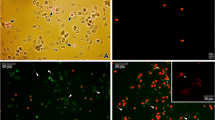Abstract
The effect of artificial gastric fluid (AGF), containing 0.5% pepsin and 0.6% hydrochloric acid, pH 1.8, in distilled water, on the excystation and metacystic development of Entamoeba invadens was examined. Excystation, which was assessed by counting the number of metacystic amoebae after inducing excystation, was enhanced by pretreatment of cysts with AGF for 30 to 60 min at 37°C but not 26°C. Longer exposure of cysts to AGF significantly reduced their viability. Significant enhancement of excystation was observed by pretreatment of cysts with distilled water only at 37°C. In addition, 0.6% hydrochloric acid had a comparable enhancing effect on excystation to AGF. Metacystic development, when determined by the number of nuclei in amoeba, was slightly enhanced by pretreatment with AGF. An artificial intestinal fluid (AIF), containing 1% pancreatin, 1% sodium bicarbonate, and 5% ox bile, pH 8.0, in distilled water, had a significant toxic effect on cysts, where 1% pancreatin had neither an enhancing effect on excystation nor a toxic effect on cysts, whereas 5% ox bile had a toxic effect on cysts. Pretreatment of cysts with AGF followed by AIF had a similar toxic effect on cysts to that by AIF only. These results suggest that gastric fluid but not intestinal fluid at 37°C contributes to enhancing excystation for Entamoeba infection.






Similar content being viewed by others
References
Bingham AK, Meyer EA (1979) Giardia excystation can be induced in vitro in acidic solutions. Nature 277:301–302
Cleveland LR, Sanders EP (1930) Encystation, multiple fission without encystment, excystation, metacystic development, and variation in a pure line and nine strains of Entamoeba histolytica. Arch Protistenkd 70:223–266
Diamond LS, Harlow DR, Cunnick CC (1978) A new medium for the axenic cultivation of Entamoeba histolytica and other Entamoeba. Trans R Soc Trop Med Hyg 72:431–432
Dobell C (1928) Researches on the intestinal protozoa of monkeys and man. Parasitology 20:357–412
Eichinger D (1997) Encystation of Entamoeba parasites. Bioessays 19:633–639
Garcia-Zapien A, Hernandez-Gutierrez R, Mora-Galindo J (1995) Simultaneous growth and mass encystation of Entamoeba invadens under axenic conditions. Arch Med Res 26:257–262
Geiman QM, Ratcliffe HL (1936) Morphology and life-cycle of an amoeba producing amoebiasis in reptiles. Parasitology 28:208–230
Heath DD, Smith JD (1970) In vitro cultivation of Echinococcus granulosus, Taenia hydatigena, T. pisiformis and T. serialis from oncosphere to cystic larva. Parasitology 61:329–343
Kumagai M, Kobayashi S, Okita T, Ohtomo H (2001) Modifications of Kohn's chlorazol black E staining and Wheatley's trichrome staining for temporary wet mount and permanent preparation of Entamoeba histolytica. J Parasitol 87:701–704
López-Romero E, Villagómez-Castro JC (1993) Encystation in Entamoeba invadens. Parasitol Today 9:225–227
Makioka A, Kumagai M, Ohtomo H, Kobayashi S, Takeuchi T (2002) Effect of proteasome inhibitors on the growth, encystation, and excystation of Entamoeba histolytica and Entamoeba invadens. Parasitol Res 88:454–459
McConnachie EW (1955) Studies on Entamoeba invadens Rodhain, 1934, in vitro, and its relationship to some other species of Entamoeba. Parasitology 45:452–481
Rengpien S, Bailey GB (1975) Differentiation of Entamoeba: a new medium and optimal conditions for axenic encystation of E. invadens. J Parasitol 61:24–30
Sanchez L, Enea V, Eichinger D (1994) Identification of a developmentally regulated transcript expressed during encystation of Entamoeba invadens. Mol Biochem Parasitol 67:125–135
Acknowledgements
We thank Dr. N. Watanabe for valuable discussion, Dr. L.S. Diamond for supplying the E. invadens, and T. Tadano for technical assistance. This work was supported by a Grant-in-Aid for Scientific Research from the Ministry of Education, Culture, Sports and Technology of Japan and by a Health Science Research Grant for Research on Emerging and Re-emerging Infectious Diseases from the Ministry of Health, Labor and Welfare of Japan.
Author information
Authors and Affiliations
Corresponding author
Rights and permissions
About this article
Cite this article
Makioka, A., Kumagai, M., Kobayashi, S. et al. Effect of artificial gastrointestinal fluids on the excystation and metacystic development of Entamoeba invadens . Parasitol Res 98, 443–446 (2006). https://doi.org/10.1007/s00436-005-0025-7
Received:
Accepted:
Published:
Issue Date:
DOI: https://doi.org/10.1007/s00436-005-0025-7




